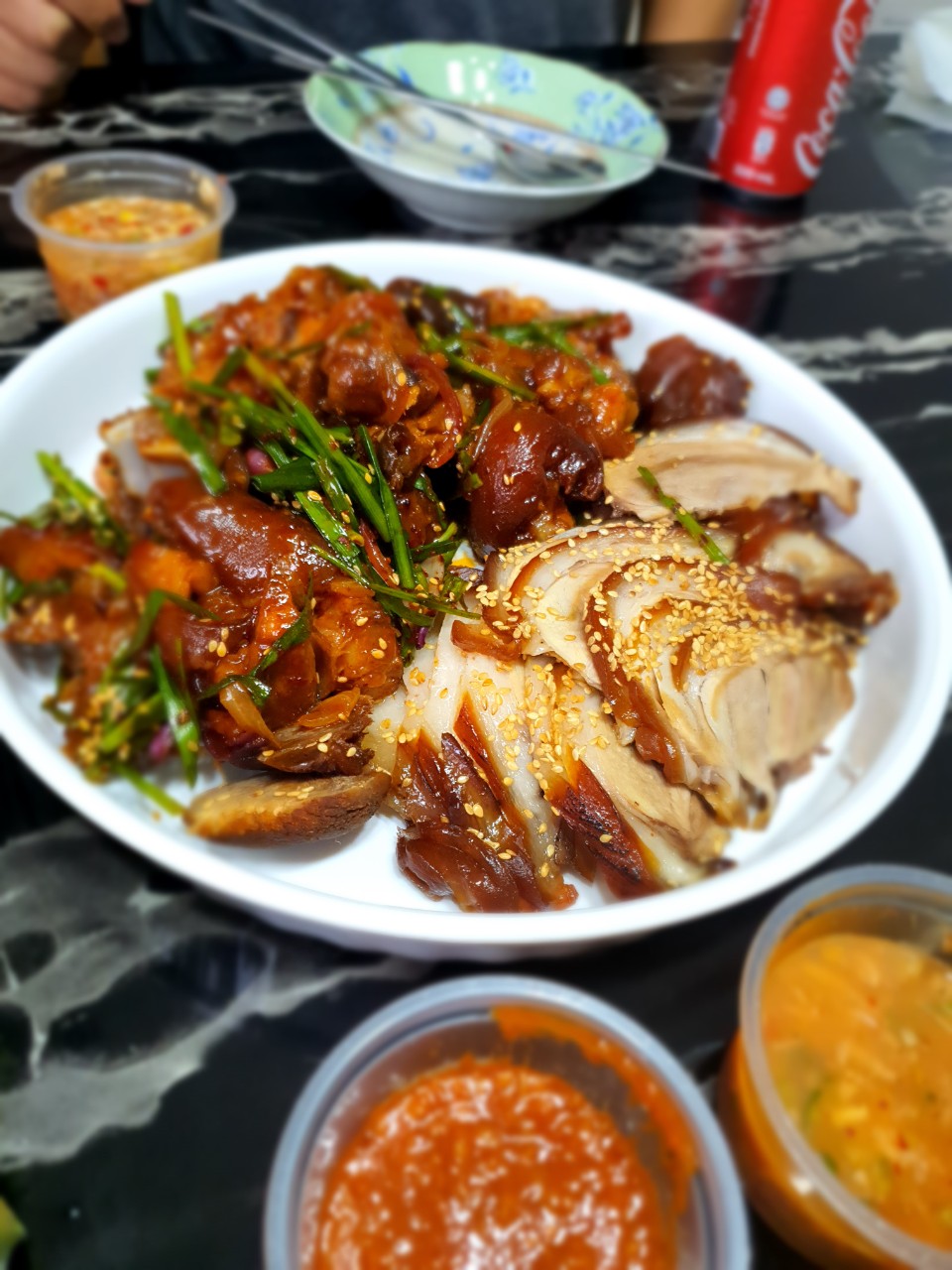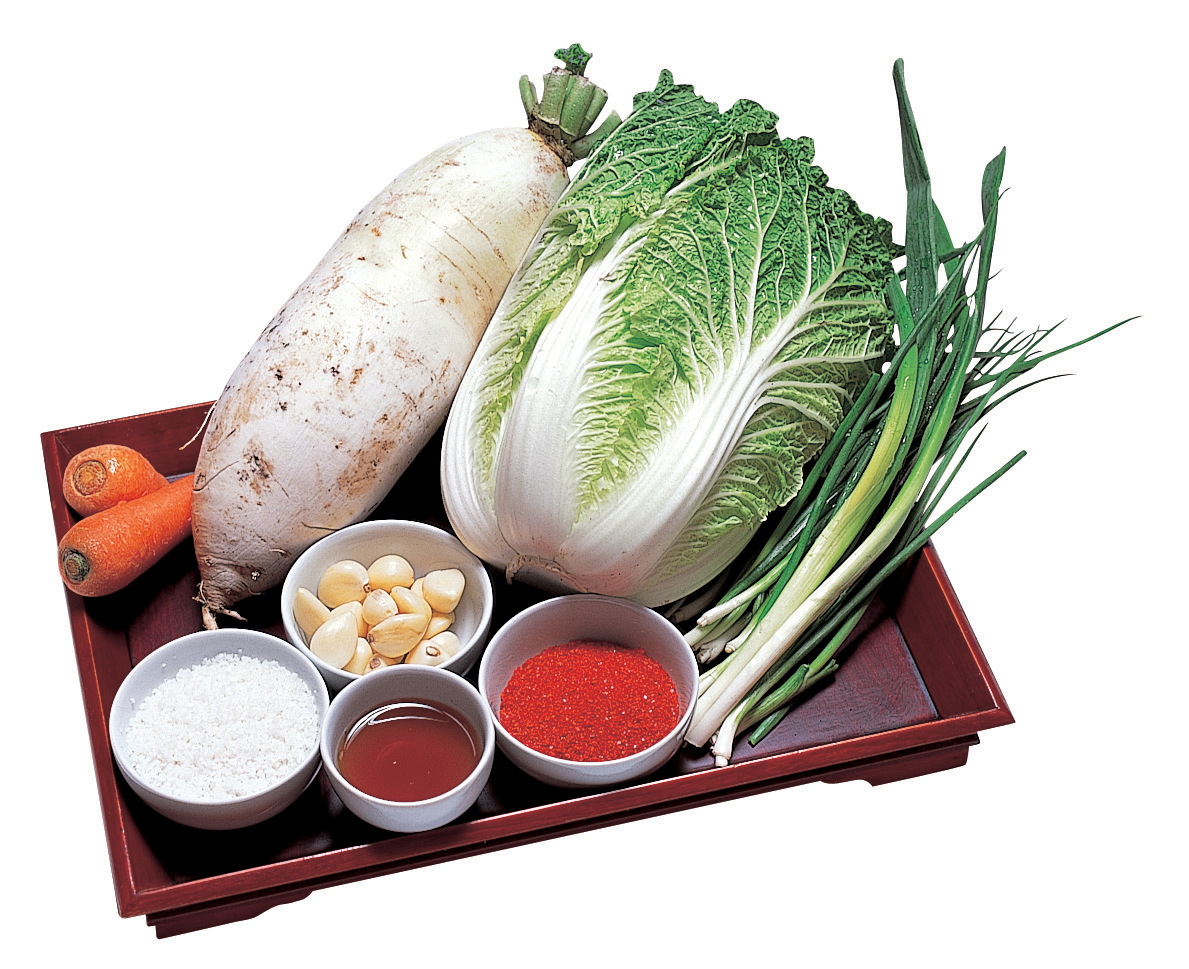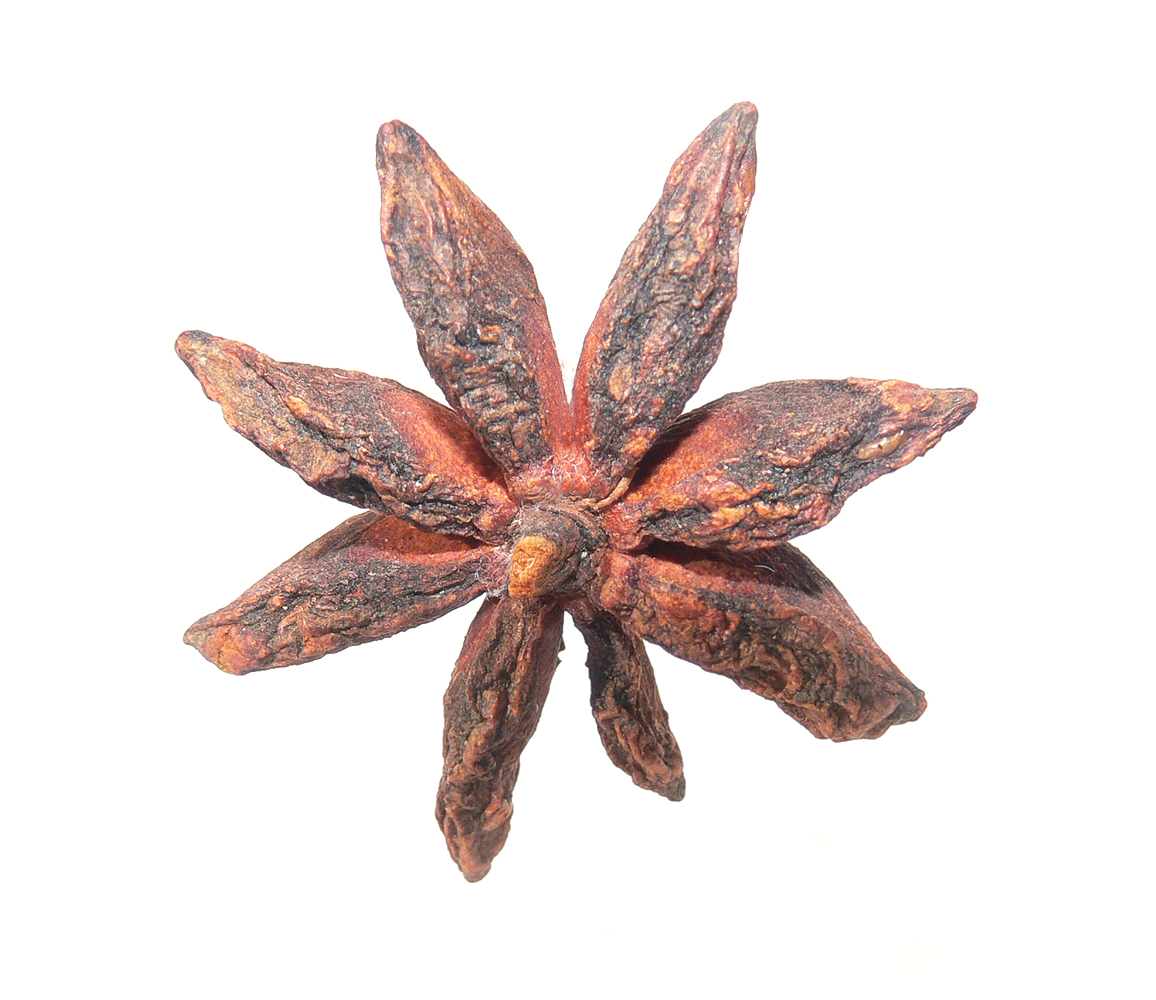|
Bossam
''Bossam'' (, 褓-) is a pork dish in Korean cuisine. It usually consists of pork shoulder that is boiled in spices and thinly sliced. The meat is served with side dishes such as spicy radish salad, sliced raw garlic, '' ssamjang'' (wrap sauce), ''saeu-jeot'' (salted shrimp), kimchi, and ''ssam'' (wrap) vegetables such as lettuce, '' kkaennip'' (perilla leaves), and inner leaves of a napa cabbage. ''Bossam'' is a popular dish in South Korea, often served as '' anju'' (i.e. food accompanying alcoholic drinks). To eat, the meat and side dishes are wrapped together in ''ssam'' vegetables, hence the literal meaning of ''bossam'': "wrapped" or "packaged". History ''Bossam'' is traditionally linked with the process of ''gimjang'', during which large quantities of kimchi are prepared for winters. To ensure the commitment of the workers during this labor-intensive process, ''yangban'' (scholar-gentry of the Joseon era) would deliver a pig for a feast. The workers would enjoy boiled pork ... [...More Info...] [...Related Items...] OR: [Wikipedia] [Google] [Baidu] |
Anju (food)
''Anju'' ( ) is a Korean term for food consumed with alcohol. It consists of a variety of foods, including both main dishes and side dishes. Consuming food with alcohol is a widespread practice in Korea, especially when the alcoholic beverage soju is involved. Certain types of foods consumed primarily as anju include golbaengi muchim, nogari with peanuts, and jokbal. History Until the Chosun Dynasty, alcohol was mainly served in (a type of inn or tavern), where soups with rice, along with traditional alcohol such as , were served to guests. Since the introduction of beer and Western foods into Korea, mainly from Japan in the nineteenth century, bars and pubs have enjoyed a newfound popularity, and many types of Western foods have been consumed as anju. By types of beverage Some foods are considered to be best complemented by certain types of alcohol. For example, samgyeopsal, grilled pork belly, is considered to go best with soju, while fried chicken or Korean seasoned ... [...More Info...] [...Related Items...] OR: [Wikipedia] [Google] [Baidu] |
Jokbal
''Jokbal''(족발) is a Korean dish consisting of pig's trotters cooked with soy sauce and spices.Jokbal at It is usually braised in a combination of soy sauce, ginger, garlic, and rice wine. Additional ingredients used can include onion, leeks, garlic, cinnamon and black pepper. History Jokbal is presumed to have originated from braised pork, a local food of Hwanghae-do, where pigs' legs are boiled. The current jokbal is a food that started in Jangchung-dong in the 1960s, and is known to have been developed by grandmothers from Pyeongan-do and Hwanghae-do for a living. In the 1960s and 1970s, it began to be widely known through visitors ...[...More Info...] [...Related Items...] OR: [Wikipedia] [Google] [Baidu] |
Pork Belly
Pork belly or belly pork is a boneless and fatty cut of meat from the belly of a pig. Pork belly is particularly popular in Hispanic, Chinese, Danish, Norwegian, Korean, Thai and Filipino cuisine. Regional dishes France In Alsatian cuisine, pork belly is prepared as ''choucroute garnie''. China In Chinese cuisine, pork belly () is most often prepared by dicing and slowly braising with skin on, marination, or being cooked in its entirety. Pork belly is used to make red braised pork belly () and '' Dongpo pork'' () in China ( sweet and sour pork is made with pork fillet). Latin American and Caribbean In Dominican, Colombian, Venezuelan, and Puerto Rican cuisine, pork belly strips are fried and served as part of '' bandeja paisa'' ''surtido'' ('' chicharrón''). In Venezuela, it is known as , not to be confused with (pork skins) (although the ''arepa'' uses fried pork belly instead of skins). Local tradition uses tocineta as one of the fillings of traditiona ... [...More Info...] [...Related Items...] OR: [Wikipedia] [Google] [Baidu] |
Doenjang
''Doenjang'' * (; "thick sauce") or soybean paste is a type of fermented bean paste made entirely of soybean and brine. It is also a byproduct of soup soy sauce production. It is sometimes used as a relish. History The earliest soybean fermentations in Korea seem to have begun prior to the era of the Three Kingdoms. The ''Records of the Three Kingdoms'', a Chinese historical text written and published in the third century AD, mentions that "Goguryeo people are good at brewing fermented soybeans" in the section named ''Dongyi'' (Eastern foreigners), in the ''Book of Wei''. Jangdoks used for doenjang production are found in the mural paintings of Anak Tomb No.3 from the 4th century Goguryeo. In ''Samguk Sagi'', a historical record of the Three Kingdoms era, it is written that ''doenjang'' and ''ganjang'' along with ''meju'' and ''jeotgal'' were prepared for the wedding ceremony of the King Sinmun in February 683. ''Sikhwaji'', a section from ''Goryeosa'' (History of Gory ... [...More Info...] [...Related Items...] OR: [Wikipedia] [Google] [Baidu] |
Los Angeles Times
The ''Los Angeles Times'' (abbreviated as ''LA Times'') is a daily newspaper that started publishing in Los Angeles in 1881. Based in the LA-adjacent suburb of El Segundo since 2018, it is the sixth-largest newspaper by circulation in the United States. The publication has won more than 40 Pulitzer Prizes. It is owned by Patrick Soon-Shiong and published by the Times Mirror Company. The newspaper’s coverage emphasizes California and especially Southern California stories. In the 19th century, the paper developed a reputation for civic boosterism and opposition to labor unions, the latter of which led to the bombing of its headquarters in 1910. The paper's profile grew substantially in the 1960s under publisher Otis Chandler, who adopted a more national focus. In recent decades the paper's readership has declined, and it has been beset by a series of ownership changes, staff reductions, and other controversies. In January 2018, the paper's staff voted to unionize and fi ... [...More Info...] [...Related Items...] OR: [Wikipedia] [Google] [Baidu] |
Banchan
''Banchan'' (, from Korean: ) or bansang are small side dishes served along with cooked rice in Korean cuisine. As the Korean language does not distinguish between singular and plural grammatically, the word is used for both one such dish or all of them combined. The basic table setting for a meal called ''bansang'' (반상) usually consists of '' bap'' (밥, cooked rice), '' guk'' or ''tang'' (soup), ''gochujang'' or ''ganjang'', '' jjigae'', and ''kimchi''. According to the number of ''banchan'' added, the table setting is called ''3 cheop'' (삼첩), ''5 cheop'' (오첩), ''7 cheop'' (칠첩), ''9 cheop'' (구첩), ''12 cheop'' (십이첩) ''bansang'', with the ''12 cheop'' used in Korean royal cuisine. ''Banchan'' are set in the middle of the table to be shared. At the center of the table is the secondary main course, such as '' galbi'' or ''bulgogi'', and a shared pot of '' jjigae''. Bowls of cooked rice and ''guk'' (soup) are set individually. ''Banchan'' are served ... [...More Info...] [...Related Items...] OR: [Wikipedia] [Google] [Baidu] |
Oyster
Oyster is the common name for a number of different families of salt-water bivalve molluscs that live in marine or brackish habitats. In some species, the valves are highly calcified, and many are somewhat irregular in shape. Many, but not all oysters are in the superfamily Ostreoidea. Some types of oysters are commonly consumed (cooked or raw), and in some locales are regarded as a delicacy. Some types of pearl oysters are harvested for the pearl produced within the mantle. Windowpane oysters are harvested for their translucent shells, which are used to make various kinds of decorative objects. Etymology The word ''oyster'' comes from Old French , and first appeared in English during the 14th century. The French derived from the Latin , the feminine form of , which is the latinisation of the Ancient Greek () 'oyster'. Compare () 'bone'. Types True oysters True oysters are members of the family Ostreidae. This family includes the edible oysters, which mainly b ... [...More Info...] [...Related Items...] OR: [Wikipedia] [Google] [Baidu] |
Baechu-kimchi
''Baechu-kimchi'' (), translated as cabbage kimchi or simply kimchi is a quintessential ''banchan'' (side dish) in Korean cuisine, made with salted, seasoned, and fermented napa cabbages. * Preparation ''Baechu-kimchi'' is made by fermenting salted napa cabbages with Korean radish, aromatic vegetables, ''jeotgal'' (salted seafood), '' gochugaru'' (chili powder) and various seasonings. Northern varieties are milder and soupier. Southern varieties are saltier and more pungent. Cabbages Korean brining salt, has a larger grain size compared to common kitchen salt, is used for the initial salting of napa cabbages. Being minimally processed, it serves to help developing flavors in fermented foods. Per water, around of salt is used. Half of the salt is dissolved in water before putting the cabbages in, and the other half is sprinkled in between the layers of napa cabbages that were washed, trimmed, and halved or quartered lengthwise. The cabbages are salted in the brine for severa ... [...More Info...] [...Related Items...] OR: [Wikipedia] [Google] [Baidu] |
Daepa
''Allium fistulosum'', the Welsh onion, also commonly called bunching onion, long green onion, Japanese bunching onion, and spring onion, is a species of perennial plant, often considered to be a kind of scallion. The species is very similar in taste and odor to the related common onion, ''Allium cepa'', and hybrids between the two ( tree onions) exist. ''A. fistulosum'', however, does not develop bulbs, and possesses hollow leaves (''fistulosum'' means "hollow") and scapes. Larger varieties of ''A. fistulosum'', such as the Japanese ''negi'', resemble the leek, whilst smaller varieties resemble chives. ''A. fistulosum'' can multiply by forming perennial evergreen clumps. It is also grown in a bunch as an ornamental plant. Names The common name "Welsh onion" does not refer to Wales but derives from a near obsolete use of "Welsh" in the sense "foreign, non-native", as the species is native to China, though cultivated in many places and naturalized in scattered locations in E ... [...More Info...] [...Related Items...] OR: [Wikipedia] [Google] [Baidu] |
Illicium Verum
''Illicium verum'' is a medium-sized evergreen tree native to northeast Vietnam and southwest China. A spice commonly called star anise, staranise, star anise seed, star aniseed, star of anise, Chinese star anise, or badian that closely resembles anise in flavor is obtained from the star-shaped pericarps of the fruit of ''I. verum'' which are harvested just before ripening. Star anise oil is a highly fragrant oil used in cooking, perfumery, soaps, toothpastes, mouthwashes, and skin creams. Until 2012, when they switched to using a bacterial source, Roche Pharmaceuticals used up to 90% of the world's annual star anise crop to produce shikimic acid, a chemical intermediate used in the synthesis of oseltamivir (Tamiflu). Etymology and nomenclature ''Illicium'' comes from the Latin ''illicio'' meaning "entice" or "seduce".Gledhill, David (2008). "The Names of Plants". Cambridge University Press. (hardback), (paperback). pp 210, 400 ''Verum'' means "true" or "genuine". The nam ... [...More Info...] [...Related Items...] OR: [Wikipedia] [Google] [Baidu] |
Doosan Corporation
Doosan Corporation is a corporate holding company headquartered in Euljiro 6-ga, Jung-gu, Seoul, South Korea. History * 1896 Park Seung-jik opened Korea's first modern dry goods store, selling cloth. * 1925 Changed the name of Park Seung-Jik Store Limited to Doosan Store * 1953 Established the Oriental Brewery and began producing OB beer. * 1960 Established Dongsan Construction and Engineering (currently Doosan Engineering & Construction)/Acquired Hapdong News Agency (currently Yonhap News) * 1966 Founded Hanyang Food * 1967 Founded Yoonhan Machinery (currently Doosan Mecatec) * 1969 Founded Hankook Bottle and Glass * 1979 Established Doosan CCK Can Manufacturing * 1980 Founded OB Seagram * 1982 Formed OB Bears (currently Doosan Bears) * 1996 Celebrated 100th anniversary. Announced Doosan Group's new Certificate of Incorporation. * 1998 Incorporated nine affiliates and re-launched the company as Doosan Corporation in September. * 2008 Acquired the Chung-Ang University Founda ... [...More Info...] [...Related Items...] OR: [Wikipedia] [Google] [Baidu] |
Doopedia
''Doosan Encyclopedia'' is a Korean language encyclopedia published by Doosan Donga (두산동아). The encyclopedia is based on the ''Dong-A Color Encyclopedia'' (동아원색세계대백과사전), which comprises 30 volumes and began to be published in 1982 by Dong-A Publishing (동아출판사). Dong-A Publishing was merged into Doosan Donga, a subsidiary of Doosan Group, in February 1985. The ''Doosan Encyclopedia'' is a major encyclopedia in South Korea. Digital edition EnCyber The online version of the ''Doosan Encyclopedia'' was named EnCyber, which is a blend of two English words: ''Encyclopedia'' and ''Cyber''. The company has stated that, with the trademark, it aims to become a center of living knowledge. EnCyber provides free content to readers via South Korean portals such as Naver. Naver has risen to the top position in the search engine market of South Korea partially because of the popularity of EnCyber encyclopedia. When Naver exclusively contracted Doosan Do ... [...More Info...] [...Related Items...] OR: [Wikipedia] [Google] [Baidu] |


.jpg)



